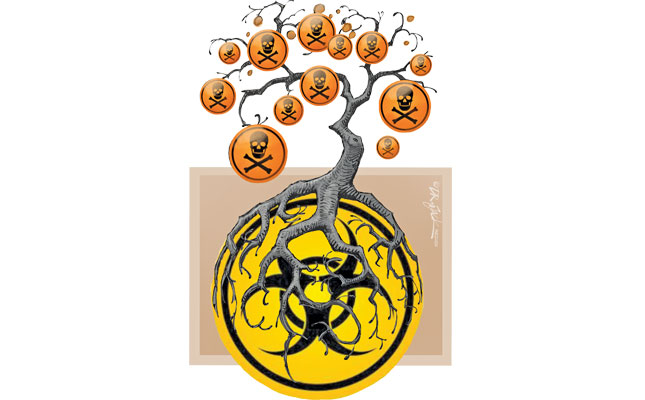
Human activities over thousands of years have left a legacy of polluted soils across the world. These activities include, amongst others, improper disposal of hazardous and urban waste, industrial processes, mining, military actions and armed conflicts, and unsustainable agricultural practices.
In sub-Saharan Africa, agriculture, mining, transport and energy generation are sources of soil pollution, with pesticide use by farmers considered the most significant contributor of soil contaminants. The application of fertiliser to enhance crop production has also been shown to be a source of soil pollution in the region.
Manure as a by-product of livestock production can result in soil pollution when the manure is disposed of in landfill areas or stockpiled on other bare soil surfaces. A study conducted at the Animal and Livestock Science experimental farm of the Federal University of Agriculture in Abeokuta, Nigeria, evaluated the levels of trace element accumulation in soil resulting from manure stockpiles of different types of animals.
The results indicated that soil pollution was most significant where poultry manure was disposed, followed by that of pigs and cattle.
Constraints to a full understanding
In parallel with sub-Saharan Africa’s rapid population growth, the estimated number of people living on less than US$1,90/day (about R30/ day) almost doubled between 1990 and 2015. With such poverty, people tend to produce their own food through subsistence or small-scale farming or forage wild vegetables, herbs and fruit.
In South Africa, vegetable gardens at schools took off as an initiative to relieve food insecurity and nutrient deficiencies amongst children. Unfortunately, analysis of soil samples in gardens close to gold-mine tailings indicated high concentrations of arsenic, lead and mercury.
Unable to afford commercial fertiliser, some small-scale farmers in the region perceive waste dump areas as fertile soil with high organic carbon content and cultivate crops there.
A case study on the correlation between trace element content of waste dump soil and bioaccumulation indicated that the vegetables produced there contain far higher levels of cadmium and lead than the limits recommended by the World Health Organization/Food and Agriculture Organization of the United Nations guidelines of 1989.
Manure and sewage sludge are widely applied as a source of fertiliser. While the soil contamination risks of this practice have been identified, many small-scale farmers remain unaware of them and continue to use such materials.
Analytical capacity for some contaminants, especially the emerging contaminants, is
available in only one country in the region:
South Africa. The only other option is to send samples to laboratories outside the region. This is problematic, as the cost of exporting samples is high and the process of obtaining export permits and special permission for soil samples is complex.
Limiting the effects of soil pollution
There are several ways in which the effects of soil pollution can be limited. If the site still has viable soil biota and natural plant colonisation, natural attenuation of the pollution without any external intervention can occur. Such solutions could be suitable for large areas that have been subject to diffuse pollution.
However, the remediation process is very slow and its effectiveness may therefore be limited. If this approach is chosen, careful assessments should be undertaken to reduce the risks of exposure to the contaminants. This could include allowing the land to remain fallow and minimising any activities that would enable the contaminants to become available.
Working the soil should be avoided, as should livestock grazing. The site will require monitoring to ensure that pollution levels are reducing and the risk assessment remains valid.
In areas with high levels of pollution and high potential for exposure, and where there are insufficient funds to remediate the soil, the only solution may be to exclude all access to the site.
It is particularly important that local human or animal populations that are vulnerable to the pollution be excluded via fencing or other physical barriers and warning signs. Institutional control with the authority and resources to enforce these restrictions should be established over the area.
If the future activities on the site are unlikely to disturb the underlying soil and the hydrogeology of the site allows it, the polluted soil may be left in situ and sealed with an impermeable layer.
This process, called capping, will minimise the effects of wind and water erosion and prevent human or animal contact with the pollutants. It is only a temporary solution, however, and should be considered only where there are constraints that prevent deployment of best-practice solutions. The capping can comprise clean soil, or a layer or tier system of materials of low permeability, such as clay.
Where pollutants have the potential to migrate through the soil, for example by liquid contaminants directly or by ground water transporting contaminants, and threaten
sensitive environmental resources such as a well, an impermeable barrier could be constructed to provide protection.
It is necessary in this case to understand the hydrogeology of the site, the conceptual site model of the pollution, and all the potential pathways for its migration in order to determine the likely effectiveness and design for such an approach.
The barrier could comprise sheet metal piles, soil and bentonite (a soft, absorbent clay) slurry walls, soil and cement walls, or injected grout barriers. For a barrier wall to be effective, it should be deep enough to reach the impervious bedrock below the groundwater.
Changing practices
Essential trace elements such as copper, iron and zinc are necessary for healthy soil biota and nutritious crops, but elevated levels of these elements can cause adverse effects. Non-essential trace elements such as arsenic, cadmium, lead and mercury are toxic even in very low concentrations.
Where soil has become polluted with marginally elevated levels of trace elements, it may be possible to lower the risks of their entering the food chain by changing agricultural practices. It is also possible to reduce plant uptake of trace elements by adding organic and inorganic amendments such as manures, biosolids, lime, zeolites, biochar or iron oxide to the soil.
The propensity to accumulate each trace element varies from crop to crop. Risk can also be reduced by changing from crops such as leafy vegetables, which have higher element accumulation rates, to less sensitive crops such as pulses, tubers and certain grains.
Crop rotation can also influence the rate of uptake. The rhizosphere effects of some plants may affect the bioavailability of a trace element to the following cropping cycle. For example, citric acid released by lupins can increase the uptake of cadmium in wheat planted in the following rotation.
In cases where agricultural land has become more heavily polluted and it is no longer safe to grow crops for human or animal consumption, it may be possible to grow non-edible crops for fibre, such as cotton or flax, trees for timber, or biomass for renewable energy generation.
The views expressed in our weekly opinion piece do not necessarily reflect those of Farmer’s Weekly.
This is an edited excerpt from the Food and Agriculture Organization of the United Nations’ report, ‘Global assessment of soil pollution’, published in 2021.











